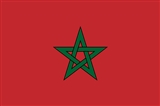
. It has a population of more than 32 million and an area of 710,850 km², and also primarily administers the disputed region of the Western Sahara
. It is part of the Maghreb
region, in addition to Tunisia
, Algeria
, Mauritania
, and Libya
, with which it shares cultural, historical and linguistic ties.
Morocco is a constitutional monarchy
with an elected parliament.
1859 Spain declares war on Morocco.
1906 The Algeciras Conference gives France and Spain control over Morocco.
1912 Sultan Abdelhafid signs the Treaty of Fez, making Morocco a French protectorate.
1912 Spain declares a protectorate over the north shore of Morocco.
1943 World War II: Franklin D. Roosevelt becomes the first President of the United States to travel via airplane while in office when he travels from Miami, Florida to Morocco to meet with Winston Churchill.
1955 In Morocco, a force of Berbers from the Atlas Mountains region of Algeria raid two rural settlements and kill 77 French nationals.
1956 Morocco declares its independence from France.
1956 Spain relinquishes its protectorate in Morocco.
1956 Tangier Protocol is signed: The international city Tangier is reintegrated into Morocco.
1956 Morocco, Sudan and Tunisia join the United Nations.

